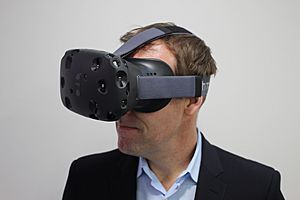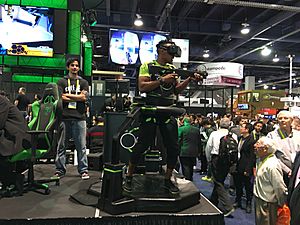Virtual reality facts for kids
Virtual reality (often just called VR) is the name for computer technology that makes a person feel like they are somewhere else. It uses software to produce images, sounds, and other sensations to create a different place so that a user feels like he or she is really part of this other place. That other place can be a real place (to take a tour in another country, for instance) or imaginary (playing a game).
A user uses a headset which consists of a screen to project the content, and speakers to produce sounds. The technology to do this needs special display screens or projectors and other devices. Often the picture will change when the user moves their head, they may be able to "walk" through this virtual space and to see things in that space from different directions, and maybe move things in that space. Haptic feedback might also be used to help make it seem more real - haptic feedback uses special gloves that make it feel like you touched something in real life.
Virtual reality is different than augmented reality, which shows the real place that a person is in, but changes or adds to it. Pokémon Go is an example of augmented reality. Augmented reality headsets are also commercially available such as the Microsoft HoloLens.
Contents
Forms and methods
One method by which virtual reality can be realized is simulation-based virtual reality. Driving simulators, for example, give the driver on board the impression of actually driving an actual vehicle.
With avatar image-based virtual reality, people can join the virtual environment in the form of real video as well as an avatar. One can participate in the 3D distributed virtual environment. Users can select their own type of participation based on the system capability.
In projector-based virtual reality, modeling of the real environment plays a vital role in various virtual reality applications, such as robot navigation, construction modeling, and airplane simulation. Image-based virtual reality systems have been gaining popularity in computer graphics and computer vision communities. In generating realistic models, it is essential to accurately register acquired 3D data; usually, a camera is used for modeling small objects at a short distance.
Desktop-based virtual reality involves displaying a 3D virtual world on a regular desktop display without use of any specialized VR positional tracking equipment. Many modern first-person video games can be used as an example, using various triggers, responsive characters, and other such interactive devices to make the user feel as though they are in a virtual world. A common criticism of this form of immersion is that there is no sense of peripheral vision, limiting the user's ability to know what is happening around them.

A head-mounted display (HMD) more fully immerses the user in a virtual world. A virtual reality headset typically includes two small high resolution OLED or LCD monitors which provide separate images for each eye for stereoscopic graphics rendering a 3D virtual world, a binaural audio system, positional and rotational real-time head tracking for six degrees of movement. Options include motion controls for more freedom of physical movement allowing the user to perform locomotive motion in any direction.
Augmented reality (AR) is a type of virtual reality technology that blends what the user sees in their real surroundings with digital content generated by computer software. The additional software-generated images with the virtual scene typically enhance how the real surroundings look in some way. AR systems layer virtual information over a camera live feed into a headset or smartglasses or through a mobile device giving the user the ability to view three-dimensional images.
Mixed reality (MR) is the merging of the real world and virtual worlds to produce new environments and visualizations where physical and digital objects co-exist and interact in real time.
A cyberspace is sometimes defined as a networked virtual reality.
Simulated reality is a hypothetical virtual reality as truly immersive as the actual reality. It enables an advanced lifelike experience or even virtual eternity.
Concerns and challenges
Health and safety
There are many health and safety considerations of virtual reality. A number of unwanted symptoms have been caused by prolonged use of virtual reality, and these may have slowed proliferation of the technology. Most virtual reality systems come with consumer warnings, including: seizures; developmental issues in children; trip-and-fall and collision warnings; discomfort; repetitive stress injury; and interference with medical devices. Some users may experience twitches, seizures or blackouts while using VR headsets, even if they do not have a history of epilepsy and have never had blackouts or seizures before. One in 4,000 people, or .025%, may experience these symptoms. Motion sickness, eyestrain, headaches, and discomfort are the most prevalent short-term adverse effects. In addition, because of the virtual reality headsets' heavy weight, discomfort may be more likely among children. Therefore, children are advised against using VR headsets. Other problems may occur in physical interactions with one's environment. While wearing VR headsets, people quickly lose awareness of their real-world surroundings and may injure themselves by tripping over, or colliding with real-world objects.
VR headsets may regularly cause eye fatigue, as does all screened technology, because people tend to blink less when watching screens, causing their eyes to become more dried out. There have been some concerns about VR headsets contributing to myopia, but although VR headsets sit close to the eyes, they may not necessarily contribute to nearsightedness if the focal length of the image being displayed is sufficiently far away.
Virtual reality sickness (also known as cybersickness) occurs when a person's exposure to a virtual environment causes symptoms that are similar to motion sickness symptoms. Women are significantly more affected than men by headset-induced symptoms, at rates of around 77% and 33% respectively. The most common symptoms are general discomfort, headache, stomach awareness, nausea, vomiting, pallor, sweating, fatigue, drowsiness, disorientation, and apathy. For example, Nintendo's Virtual Boy received much criticism for its negative physical effects, including "dizziness, nausea, and headaches". These motion sickness symptoms are caused by a disconnect between what is being seen and what the rest of the body perceives. When the vestibular system, the body's internal balancing system, does not experience the motion that it expects from visual input through the eyes, the user may experience VR sickness. This can also happen if the VR system does not have a high enough frame rate, or if there is a lag between the body's movement and the onscreen visual reaction to it. Because approximately 25–40% of people experience some kind of VR sickness when using VR machines, companies are actively looking for ways to reduce VR sickness.
Vergence-accommodation conflict (VAC) is one of the main causes of virtual reality sickness.
In January 2022 The Wall Street Journal found that VR usage could lead to physical injuries including leg, hand, arm and shoulder injuries. VR usage has also been tied to incidents that resulted in neck injuries (especially injures to the cervical vertebrae).
Children and teenagers in virtual reality
Children are becoming increasingly aware of VR, with the number in the USA having never heard of it dropping by half from Autumn 2016 (40%) to Spring 2017 (19%).
A 2022 research report by Piper Sandler revealed that only 26% of U.S. teens own a VR device, 5% use it daily, while 48% of teen headset owners "seldom" use it. Of the teens who don't own a VR headset, 9% plan to buy one. 50% of surveyed teens are unsure about the metaverse or don't have any interest, and don't have any plans to purchase a VR headset.
Studies show that young children, compared to adults, may respond cognitively and behaviorally to immersive VR in ways that differ from adults. VR places users directly into the media content, potentially making the experience very vivid and real for children. For example, children of 6–18 years of age reported higher levels of presence and "realness" of a virtual environment compared with adults 19–65 years of age.
Studies on VR consumer behavior or its effect on children and a code of ethical conduct involving underage users are especially needed. Related research on violence in video games suggests that exposure to media violence may affect attitudes, behavior, and even self-concept. Self-concept is a key indicator of core attitudes and coping abilities, particularly in adolescents. Early studies conducted on observing versus participating in violent VR games suggest that physiological arousal and aggressive thoughts, but not hostile feelings, are higher for participants than for observers of the virtual reality game.
Experiencing VR by children may further involve simultaneously holding the idea of the virtual world in mind while experiencing the physical world. Excessive usage of immersive technology that has very salient sensory features may compromise children's ability to maintain the rules of the physical world, particularly when wearing a VR headset that blocks out the location of objects in the physical world. Immersive VR can provide users with multisensory experiences that replicate reality or create scenarios that are impossible or dangerous in the physical world. Observations of 10 children experiencing VR for the first time suggested that 8-12-years-old kids were more confident to explore VR content when it was in a familiar situation, e.g. the children enjoyed playing in the kitchen context of Job Simulator, and enjoyed breaking rules by engaging in activities they are not allowed to do in reality, such as setting things on fire.
Privacy
Digital privacy concerns have been associated with VR platforms; the persistent tracking required by all VR systems makes the technology particularly useful for, and vulnerable to, mass surveillance, including information gathering of personal actions, movements and responses. Data from eye tracking sensors, which are projected to become a standard feature in virtual reality headsets, may indirectly reveal information about a user's ethnicity, personality traits, fears, emotions, interests, skills, and physical and mental health conditions.
The nature of VR technology means that it can gather a wide range of data about its users. This can include obvious information such as usernames and account information, but also extends to more personal data like physical movements, interaction habits, and responses to virtual environments. In addition, advanced VR systems can capture biometric data like voice patterns, eye movements, and physiological responses to VR experiences. Virtual reality technology has grown substantially since its inception, moving from a niche technology to a mainstream consumer product. As the user base has grown, so too has the amount of personal data collected by these systems. This data can be used to improve VR systems, to provide personalized experiences, or to collect demographic information for marketing purposes. However, it also raises significant privacy concerns, especially when this data is stored, shared, or sold without the user's explicit consent.
Existing data protection and privacy laws like the General Data Protection Regulation (GDPR) in the EU, and the California Consumer Privacy Act (CCPA) in the United States, can be applied to VR. These regulations require companies to disclose how they collect and use data, and give users a degree of control over their personal information. Despite these regulations, enforcing privacy laws in VR can be challenging due to the global nature of the technology and the vast amounts of data collected.
Due to its history of privacy issues, the involvement of Meta Platforms (formerly Facebook, Inc.) in the VR market has led to privacy concerns specific to its platforms. In August 2020, Facebook announced that Oculus products would become subject to the terms of use and privacy policy of the Facebook social network, and that a Facebook account would be required to use future Oculus headset models, and all existing models (via deprecation of the separate Oculus account system) beginning January 2023. The announcement was criticized for the mandatory integration of Oculus headsets with Facebook data collection and policies, and preventing use of the hardware if the user's account is suspended. The following month, Facebook halted the sale of Oculus products in Germany due to concerns from regulators that the new policy was a violation of GDPR. In 2022, the company would later establish a separate "Meta account" system.
Images for kids
-
Researchers with the European Space Agency in Darmstadt, Germany, equipped with a VR headset and motion controllers, demonstrating how astronauts might use virtual reality in the future to train to extinguish a fire inside a lunar habitat
-
NASA Ames's 1985 VIEW headset
-
Virtual Fixtures immersive AR system developed in 1992. Picture features Dr. Louis Rosenberg interacting freely in 3D with overlaid virtual objects called 'fixtures'
-
The Project Morpheus (PlayStation VR) headset worn at gamescom 2015
-
Smartphone-based budget headset Samsung Gear VR in dismantled state
-
Apollo 11 astronaut Buzz Aldrin previewing the Destination: Mars VR experience at the Kennedy Space Center Visitor Complex in 2016
-
U.S. Navy medic demonstrating a VR parachute simulator at the Naval Survival Training Institute in 2010
See also
 In Spanish: Realidad virtual para niños
In Spanish: Realidad virtual para niños














